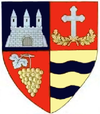Săvârșin
Săvârşin | |
|---|---|
| Country | |
| County | Arad County |
| Population (2002)[1] | 3,290 |
| Time zone | UTC+2 (EET) |
| • Summer (DST) | UTC+3 (EEST) |
Săvârşin (Hungarian: Soborsin) is a commune in Arad County, Romania. Săvârșin commune lies at the foot of Metaliferi Mountains, at its contact point with the Mureș Couloir. Its surface occupies approximately 22000 hectares and it is formed of nine villages: Săvârșin - the commune centre situated at 87 km far from Arad, Căprioara, Cuiaş, Hălăliş, Pârneşti, Temeşeşti, Toc, Troaş si Valea Mare.
Population
According to the last census the population of the commune counts 3290 inhabitants, out of which 98,1% are Romanians, 1,0% Hungarians, 0,3% Ukrainians, 0,3% Serbs and 0,3% are of other or undeclared nationalities.
History
The first documentary records of Săvârșin, Hălăliş, Pârneşti, Temeşeşti date back to 1479. Căprioara was attested documentarily in 1256, Cuiaş in 1477, Toc in 1743, Troaş in 1828 and Valea Mare in 1717.
Economy
Agriculture, silviculture, timber industry, industry of building materials represented by exploitation of granite ( Săvârșin) and marble (Căprioara), mining based on exploitation of molybdenum (Troaș) and tourism are the main economic branches of the commune.
Tourism
Its touristic potential is an exceptional one. The natural reservations called "Peștera lui Duţu" and "Peștera lui Sinesie", the collections of decorative fine arts (universal graphics, graphics and paintings made by Eugen Popa and Gina Hagiu) and of ethnography in Săvârșin, the ethnographic museum with popular costumes, folkweave, icons, ceramics in Temeșești, the wooden church called "Sfinţii Trei Ierarhi" (1782) in Troaș, the reinforced settlement and the archaeological site situated in "Dâmbul Tătarilor" and "Gomile" are only a few of the numerous spectacles which are worth visiting.
Beside these, the Săvârşin Castle (18th century), owned by His Majesty King Michael I of Romania increases the touristic potential of the commune. In 2005 the royal residence in Săvârșin entered the touristic circuit, but since 2007 it has been in restoration and cannot be visited until the renovation is completed.[2] [3]
46°01′N 22°14′E / 46.017°N 22.233°E
References
